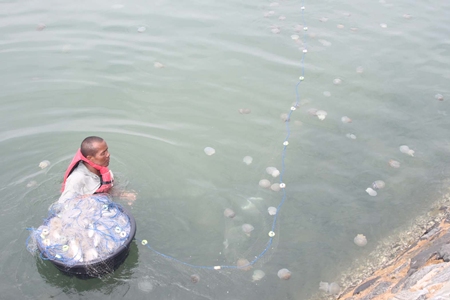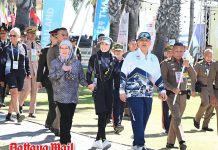Scuba divers and beachgoers beware: Perhaps as many as a million jellyfish have moved into Sattahip Bay making a day at the beach a potentially painful experience.
Royal Thai Navy officials said the invasion of the dangerous, but not usually deadly, “moon jellyfish” pushed fishermen out of shallow waters and beachgoers out of the surf. Most of the stinging scyphozoans have been spotted in Tuay-gnarm Bay and Dongtan Bay.
 This fellow doesn’t seem to be overly bothered by the stings as he tries to gather as many jellyfish as he can.
This fellow doesn’t seem to be overly bothered by the stings as he tries to gather as many jellyfish as he can.
Soi Yenrudee resident Somchai Chijprajong, 45, said he and other local fishermen pulled as many as 400,000 jellies out of the sea with their nets. He said he’s never seen so many and said it must have been caused by anomalous sea conditions.
Somchai didn’t escape his close encounter unscathed, however. Like other fishermen, he suffered a number of stings, which he and Navy officials said can be treated by crushing and applying wild Morning Glory cultivated by the Navy on area beaches. Scuba divers, many of whom could find their next dives in Samae San a painful experience, generally treat jellyfish stings with vinegar and hot water.
Sattahip District Chief Chaichan Iamcharoen urged people to take care to avoid the jellyfish, as people may have undetected allergies to the poison. The plume could dissipate within 10 days, he said.
Aurelia aurita – also known as “moon,” “saucer,” or “common” jellyfish – usually about 25-40cm in diameter, and can be recognized by its four horseshoe-shaped gonads that are easily seen through the top of the bell.







